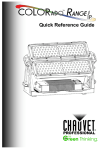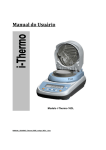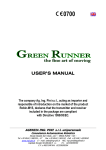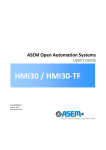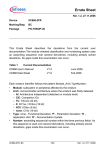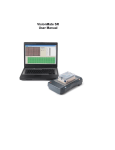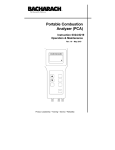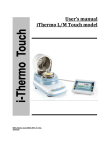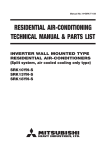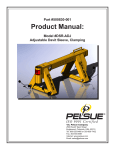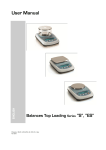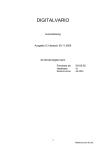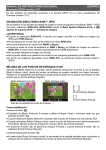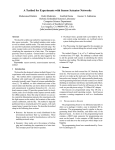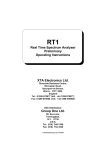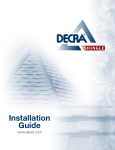Download User Manual - Affordable Scales & Balances
Transcript
User Manual i-Thermo 163M and i-Thermo 163L USER_MANUAL_BIL_SERIE_iThermo (EN)_nologo_REV1_1.doc September 2010 INDEX 1 INSTALLATION INSTRUCTIONS ............................................................................................... 2 2 STORAGE CONDITIONS ............................................................................................................... 4 3 PREPARING THE BALANCE TO WORK .................................................................................. 5 4 KEYBOARD AND DISPLAY .......................................................................................................... 6 5 INPUTS AND OUTPUTS ................................................................................................................. 7 5.1 6 WEIGHING ........................................................................................................................................ 8 6.1 6.2 7 REAR SIDE AND BOTTOM SIDE OF THE BALANCE MODEL I-THERMO ............................................ 7 STAND BY ..................................................................................................................................... 8 SIMPLE WEIGHING ......................................................................................................................... 8 CALIBRATION ................................................................................................................................. 9 7.1 EXTERNAL CALIBRATION BALANCES ............................................................................................ 9 7.1.1 External calibration ................................................................................................................. 9 8 TARE FUNCTION .......................................................................................................................... 10 9 HOW TO SET BALANCE’S FUNCTIONS ................................................................................ 11 9.1 9.2 9.3 9.4 9.5 10 TRANSMISSION SPEED SELECTION............................................................................................... 11 AUTOZERO FUNCTION ................................................................................................................. 12 FILTERS SELECTION..................................................................................................................... 13 STABILITY FUNCTION .................................................................................................................. 14 BACKLIGHT SETUP ...................................................................................................................... 15 HOW TO SET HEATER’S FUNCTIONS ................................................................................... 16 10.1 MEASURE FUNCTION .................................................................................................................. 16 10.1.1 Mode using a saved program ............................................................................................ 17 10.1.2 PrG time mode ................................................................................................................... 18 10.1.3 PrG Auto Mode .................................................................................................................. 21 10.2 PRG SET FUNCTION ..................................................................................................................... 23 10.3 SERIAL FUNCTION ....................................................................................................................... 24 10.4 SERVICE ...................................................................................................................................... 26 10.5 VERSIONE SOFTWARE ................................................................................................................. 26 11 RS232 INTERFACE FEATURES ................................................................................................. 27 12 CONNECTORS POSITION (REAR) ........................................................................................... 30 13 ERROR CODES .............................................................................................................................. 31 14 MAINTENANCE AND CARE ...................................................................................................... 31 15 QUICK GUIDE TO BALANCE PARAMETERS SETTINGS................................................. 32 16 QUICK GUIDE TO THE USE OF THE BALANCE’S PROGRAMS .................................... 33 17 BALANCE TECHNICAL FEATURES........................................................................................ 34 18 HEATER TECHNICAL FEATURES .......................................................................................... 34 19 OPTIONAL ACCESSORIES......................................................................................................... 35 20 WARRANTY .................................................................................................................................... 35 21 EQUIPMENT DISPOSAL.............................................................................................................. 35 1 1 Installation instructions WARNING: Please follow carefully these steps for installing and use the new balance before starting your work routine. A way of use of the instrument different from this user manual will not guarantee the instrument’s safety anymore. Keep this manual in a safe place. Please follow these indications to avoid problems and to grant a safe use of moisture analyzer: Use the moisture analyzer exclusively for the moisture determination of samples. Every incorrect use of this instrument may create danger for safety of persons and may cause damages at the instrument or at other objects. Do not use the instrument in areas where there is danger of explosions; also make the instrument work only respecting the enviroment conditions as reported in this manual. If this material is used in plants or in enviroment conditions that require strict safety conditions, please respect the instructions of the directives regarding the installation of this material currently existing in your country. This instrument must be used only by qualified personell, who knows the features and characheristics of the sample under test. Before starting to work with the instrument for the first time, please check that voltage is the same of your electric mains. To get the instrument free from tension, remove the power supply cable. Place straight the power supply cable so that to avoid contact with the very hot surfaces of the instrument. Use only extension cables that are conform to normatives and that are equipped of a protection conductor. Attention, protection against heat Respect the distance and the free space around the instrument to avoid an accumulation of heat in the instrument and and the over heating of the instrument ifself: - 20 cm around the instrument - 1 m upon the instrument Do not place flammable materials upon, below or near the instrument since the heater warms the surroinding area. Remove the samples carefully, the heater and the dishes for samples may be still very hot. Danger for persons or objects when working with particular samples: Fire Explosion Flammable or explosive substances Substances that contain solvents Substances that during drying emit gas or flammable explosive vapors 2 Remove the balance and the calibration weight from package and verify if there are any visible damages to the instrument Do not install the balance in a place with air flows, heavy thermic changes and vibrations. The humidity rate of the balance environment must be between 45% and 75% Place the weighing pan and the support pan on the balance (see section 3). Level the balance using the level bubble and levelling feet located underneath the case Level bubble placed on the rear side of the balance Adjustable feet Connect the power supply to the connector 2 place on the rear side of the balance and the cable of the heater on the right connector placed on the rear side of the heater (see sec. 5). Connect the power supply and the cable of the heater to an electric plug near the instrument, that must be easily accesible; after few seconds the balance will switch on by itself. From switch on wait for 30 minutes and then calibrate the balance using the supplied calibration weight, following the instructions (sec. 7) Calibrate the balance each time that it is moved from one place to another. Check periodically the calibration of the balance. It is reccomended not to let fall too heavy objects on the balance’s pan, to avoid damaging the balance. Service must be effected by qualified personell and the spare parts used must be original. In order to comply with this it is necessary to call the reseller where the balance has been bought. 3 2 Storage conditions . Storage temperature +5 °C…+40°C Storage humidity 45% - 75%. Keep the balance’s package in the event that the balance must be sent to the service center, remove all cables and accessories to avoid any damage during transportation. Keep the balance far from extreme temperature and humidty, and avoid violent hurts. 4 3 Preparing the balance to work Stainless pan protection with ventilation stopper Underpan Pan extractor Pan for the sample 1. 2. 3. 4. Insert stainless pan protection. Insert underpan on the cone of weigth. Insert pan extractor Put the pan for the sample. 9 poles M/F cable for connection balance-heater Heater power supply Balance power supply 1. Connect the heater to balance by using the proper cable. 2. Plug the heater. 3. Plug the balance. 5 4 Keyboard and display ESC Standby (OFF) or power on (ON) button Escape function button TARE or zero button . * Stability indicator O Zero indicator % Percenage weighing Battery charge indicato Insert data mode Selection CONFIRM or SEND data to printer button. H Balance setup MENU button, to set balance’s parameters. Balance CALIBRATION button. 6 g Heater is working Measure unit 5 Inputs and outputs 5.1 Rear side and bottom side of the balance model I-Thermo 1. CONNECTOR 1 Connect balance to heater. 5 6 4 5 4 2. CONNECTOR 2 Balance’s power supply. 6 3 3 3. CONNECTOR 3 Heater’s power supply 4. CONNECTOR 4 RS232 Interface for PC and printer 5. CONNECTOR 5 Connect heater to balance. 2 1 1 2 6. SWITCH I/0 to switch on/off the heater 7 7 7. ADJUSTABLE FEET 3 9 8. Closing screws of the balance 11 10 9. Closing screws of the balance.First remove the screws remove adjustabel rear feet(10) and fixed rear feet(11). 10. ADJUSTABLE REAR FEET 11. FIXED REAR FEET 8 7 6 Weighing After having connected the balance to AC outlet, it will perform an internal circuits test, therefore that the balance will set itself in stand-by mode. . 6.1 Stand By From “STAND BY” mode: Press ON/OFF button to bring balance to work conditions. Press again ON/OFF button to return to “STAND BY” condition. 6.2 Simple weighing Place the sample to weigh on the pan and read the value of weight on the display as soon as the symbol ж (asterisk) of stability appears 8 7 Calibration Electronic balances operate mass measurements making use of gravity (g). Difference of latitude in geographic areas and altitude will vary gravity acceleration value (g). Therefore, for accurate measurements, the balance must be adjusted to the local environment. This adjustment is accomplished by calibration function. 7.1 External calibration balances 7.1.1 External calibration Calibration is accomplished by pressing CAL button. 1. Press CAL button when pan is empty, “0-t” are displayed on the display.. 2. When calibration weight value starts to flash, load the weight on the pan. 3. The display will stop flashing, indicating calibration weight value. Once the calibration is effected will be shown the value of the calibrated wight and the current unit of measure. 4. Unload calibration weight from the pan. The balance is ready for weighing operations NOTE: if there is an interference during calibration process, an error message will be displayed. 9 8 Tare function 1. Load the container on the pan. The display will show the weight. 2. Press O/T button. “O-t” indication will be displayed 3. After reaching stability, the value “0.000” will be displayed. If the stability is not achieved (due to air flows or vibrations or other disturbs) the “0-t” will remain displayed. 4. Load the objects to weigh in the container. Read net weight value on display. 10 9 How to set Balance’s functions 9.1 Transmission speed selection 1. From zero condition on display, press and keep pressed the MENU button until to buzzer sound off, then release the button. The message “unitS” is displayed, then press MENU button until the message “BAUD RT” is displayed and confirm by pressing the PRINT button. . 2. Select serial data transmission speed (1200-2400-4800-9600 baud). Pressing MENU or CAL buttons it will be possible to scroll forward or backward trough the different transimission speeds, then confirm your choice by pressing PRINT button. 3. After having selected the transmission speed you wish, press the MENU button to go to next parameter or CAL button to go to previous one. 4. To escape from parameters setup menu, press the MENU button until, to buzzer sound off then release the button. 5. The balance will return to standard weighing conditions 11 9.2 Autozero function Autozero is an automatic correction of a possible zero drift. Au0 OFF Au0 1 Au0 2 Au0 3 Au0 3E = autozero disabled = soft autozero = medium autozero = heavy autozero = heavy autozero over all range 1. From zero condition on display, press and keep pressed the MENU button until to buzzer sound off, then release the button. The message “unitS” is displayed, then press MENU button until the message “AUTO 0” is displayed, then press PRINT to confirm 2. Pressing MENU or CAL button it will be possible to scroll forward or backward through the different autozero levels, select the one you wish and confirm it by pressing the PRINT button 3. After having selected the autozero level you wish, press the MENU button to go to next parameter or CAL button to go to previous one. 4. To escape from parameters setup menu, press the MENU button until to buzzer sound off, then release the button. 5. The balance will return to standard weighing conditions. 12 9.3 Filters selection It is possible to adapt the balance to the different enviroment conditions thanks to the selection of three filters: FILTER 1: proportion of ingredients condition FILTER 2: stable conditions FILTER 3: unstable conditions 1. From zero condition on display, press and keep pressed the MENU button until to buzzer sound off, then release the button. The message “unitS” is displayed, then press MENU button until the message “FILTER” is displayed then confirm it by pressing the PRINT button 2. Pressing MENU or CAL button it will be possible to scroll forward or backward the different filtering levels, select the one you wish and then confirm it by pressing the PRINT button 3. After having selected the filtering level you wish, press the MENU button to go to next parameter or CAL to go to previous one. 4. To escape from parameters setup menu, press the MENU button until to buzzer sound off, then release the button. 5. The balance will return to standard weighing conditions NOTE: It is suggested to use FILTER 1 when proportion of ingredients must be performed 13 9.4 Stability function The stability symbol is displayed when the weight is stable inside a defined range STAB 1 = for stable enviroments STAB 2 = for not so stable enviroments STAB 3 = for unstable enviroments 1. From zero condition on display, press and keep pressed the MENU button until to buzzer sound off, then release the button. The message “unitS” is displayed, then press MENU button until the message “StAbiL ” is displayed, then confirm this by pressing the PRINT button. 2. Pressing MENU or CAL button it will be possible to scroll forward or backward the different stability levels, select the one you wish and then confirm it by pressing the PRINT button. 3. After having selected the stability level you wish, press the MENU button to go to next parameter or the CAL button to go to previous one. 4. To escape from parameters setup menu, press the MENU button until to buzzer sound off, then release the button. 5. The balance returns to normal weighing conditions. 14 9.5 Backlight setup The balance display is equipped with backlight to make the indication more visible also during low light conditions. There are 3 working modes: ON = backlight ON OFF = backlight OFF AUTO = backlight automatically switched on during weighing operations 1. From zero condition on display, press and keep pressed the MENU button until to buzzer sound off, then release the button. The message “unitS” is displayed, then press MENU button until the message “bLt ” , then press the PRINT button to confirm this. 2. Pressing MENU or CAL button it will be possible to scroll forward or backward the different working modes, select the one you wish and then confirm it by pressing the PRINT button 3. After having selected the backlight working mode you wish, press the MENU button to go to next parameter or the CAL button to go to previous one. 4. To escape from parameters setup menu, press the MENU button until to buzzer sound off, then release the button. 5. The balance returns to normal weighing conditions. 15 10 How to set Heater’s functions 1. From condition of zero on display, press the MENU button and you will read “therM”on the display, press PRINT button to confirm. 2. Select the desired function using the MENU (scroll forward) and CAL (scroll backward) buttons to navigate through the functions menu, then press the ENTER button to confirm your selection. 10.1 Measure Function This function allows you to enter the selection of the drying method: PrG 1 Drying mode using the stored program 1 PrG 2 Drying mode using the stored program 2 PrG 3 Drying mode using the stored program 3 PrG 4 Drying mode using the stored program 4 PrG 5 Drying mode using the stored program 5 PrG time Time drying mode PrG Auto Autostop drying mode Pressing the MENU or CAL buttons to scroll forward or backward the different drying modes, then select the you choice and confirm it using the PRINT button. ....... 16 10.1.1 Mode using a saved program Selecting one of the modes PrG 1 PrG 2 PrG 3, PrG 4 PrG 5 it is possible to recall a drying program previously stored. After selecting the desired program, press ENTER to confirm. You will read on display the following message: Use the MENU button to activate (“YES”) or deactivate (“NO”) the function of pre-heating of the heater. This function allows to bring and to keep the heater temperature to the value set before the start of the drying cycle. The choice will be kept memorized until the instrument is switched off. If the function is activated after the ENTER button has been pressed , then the WAIT message will be displayed. As the set temperature is reached, it will be maintained and the display will show the following message: Press the ENTER button to go on It is now visualized weight indication along with the symbol . Effect the Tare if necessary and load the sample to examine, wait for stability and then press ENTER to let start the drying cycle. 17 During drying cycle it will be visualized the symbol H (=heater is working). It is possible to stop the cycle at any moment pressing the ON/OFF button. It is also possible to see the drying parameters pressing sequentially the MENU button: Please read the section “Prg Set Function” to know how to store programs 10.1.2 PrG time mode Selecting this drying mode it is possible to set the proper temperature and drying time values. After you confirm the Prg TIME mode, it is first asked to set the duration of the cycle and then the value of drying temperature. The time can be set from 1 to 99 minutes using the CAL and MENU buttons to increase or decrease the value of time, then confirm with the ENTER button. Set now the choosen temperature using the CAL and MENU buttons to increase and decrease the value of temperature, then confirm using the ENTER button. 18 The following message is then displayed: Use the MENU button to activate (“YES”) or deactivate (“NO”) the function of pre-heating of the heater. This function allows to bring and to keep the heater temperature to the value set before the start of the drying cycle. The choice will be kept memorized until the instrument is switched off. If the function is activated after the ENTER button has been pressed , then the WAIT message will be displayed. As the set temperature is reached, it will be maintained and the display will show the following message: Press the ENTER button to go on. It is now visualized weight indication along with the symbol . Effect the Tare if necessary and load the sample to examine, wait for stability and then press ENTER to let start the drying cycle. 19 During drying cycle it will be visualized the symbol H (=heater is working). It is possible to stop the cycle at any moment pressing the ON/OFF button. It is also possible to see the drying parameters pressing sequentially the MENU button: Percentual loss of moisture Percentual dry residual Ratio of initial weight/dry residual weight in percentual Actual temperature Time remaining At the end of the cycle the instrument will give out an acoustic signal for about 15 secods and on the display it will be visualized the final value with the OK symbol (=cycle is finished). Press the ON/OFF button to escape and to go to the next sample to examine. 20 10.1.3 PrG Auto Mode Selecting this mode it is possible to activate the automatic drying mode. Setting the value of temperature and the choosen value of minimum moisture loss (time interval 60sec), the balance will stop automatically the drying process when the moisture loss will go below the value setted by the user. Insert the value of desired percentual minimum moisture loss in the range 0.1 – 9.9% , using the CAL and MENU buttons to increase and decrease this value, then confirm using ENTER. Now set the proper choosen temperature using CAL and MENU to increase and decrease the value of temperature, then confirm using ENTER. The following message will be displayed Use the MENU button to activate (“YES”) or deactivate (“NO”) the function of pre-heating of the heater. This function allows to bring and to keep the heater temperature to the value set before the start of the drying cycle. The choice will be kept memorized until the instrument is switched off. If the function is activated after the ENTER button has been pressed , then the WAIT message will be displayed. 21 As the set temperature is reached, it will be maintained and the display will show the following message: Press the ENTER button to go on. It is now displayed the weight indication along with the symbol: Effect Tare if necessary and load the sample to examine, wait for stability and press ENTER to let the drying cycle start. During drying cycle it will be visualized the symbol H (=heater is working). It is possible to stop the cycle at any moment pressing the ON/OFF button. During the drying cycle it is possible to see the drying parameters pressing sequentially the MENU button. When the rate of moisture loss is below of setted valure, automatically the drying process is stopped and the buzzer soun will be for about 15 seconds, on the display it is visualized the analise result with the symbol OK (=cycle is finished). Press the ON/OFF button to escape and to go to the next sample to examine. 22 10.2 Prg Set Function This function allows to store upto 5 different drying programs (Prg1, Prg2, Prg3, Prg4, Prg5) It is displayed the program Prg 1 , press the MENU or CAL to scroll forward or backward the drying programs, then select the one desired pressing the PRINT button ....... After having selected the program, choose the desired drying mode, Time Mode or Auto Mode. Depending on the choosen mode, insert drying parameters as described in the section 10.1.2 for the time mode, and in the section10.1.3 for the automatic mode. It is now asked if the data that has been set must be saved or not: 23 Use the MENU and CAL buttons to choose Yes or No. Then confirm with ENTER. Then the program is saved and the previous one is deleted. It is now possible to store another program or it is possible to escape from the programs menu using the ON/OFF button. 10.3 Serial Function This function allows to select the different modes of data transmission. Confirm with ENTER to enter the menu of transmission mode selection. The data transmission modes are the following: Manu Prt Auto Prt Manu PC Auto PC Weig PC Manu T50 Auto T50 Print is done only if PRINT button is pressed Print is done automaticaly at the end of the test. Data are transmitted to PC only after PRINT button is pressed. Data are transmitted to PC automaticaly at the end of the test The value of weigh is transmitted continuosly to PC Print is done only if PRINT button is pressed. (for printer TLP50) Print is done automaticcaly at the end of the test. (for printer TLP50) Pressing the MENU or CAL buttons it is possible to scroll forward or backward the different drying modes, then select the one you want and confirm with the PRINT button 24 Press ON/OFF button to escape from Serial menu 25 10.4 Service This function is reserved to the technical staff. 10.5 Versione Software This menu allows to visualize the version of the software installed in the heater Confirm with the ENTER button to visualize the software version Press again the ENTER button to exit 26 11 RS232 interface features 1. General features The balance transmits the value visualized on its display using serial RS232C standard, allowing to print the value of weight and relative drying data to a PC monitor or to a serial printer. Both in the print to PC mode and in the print to Printer mode, it is possible to select the automatic transmission (“Auto”) or manual transmission (“Manu”) pressing the PRINT button( as described in section 10.3).The speed of transmission and recepetion can be selected as previously described (section 9.1) at 1200, 2400, 4800, and 9600 baud. The characheter format is of 8 bit preceded by one bit of start and followed by a bit of stop. Parity is not applied. N.B.: Serial data transmission is activated only after the drying cycle is entered, with the heater cover closed. 2. Connecting the balance to PC For the transmission of the data, connect the connector 1 located behind the hoven to the serial port of the PC, as illustrated in the following drawing : Hoven side Connector 1 Hoven side Connector 1 2 3 5 6 3 2 7 6 4 20 2 3 5 6 2 3 5 6 4 4 3. Transmission format 27 PC side Connector 25 Poles PC side Connector 9 Poles In the following table are shown the different transmission formats: Weig PC 1°. 2° 3° 4° 5° 6° Weight 7° 8° 9° 10° 11° 12° 13° 14° 15° 16° 17° 18° 19° : space Sign Value of weight space g Manu PC At the end of drying cycle, after pressing the PRINT button, it is transmitted the following string of data: 1°. 2° 3° 4° 5° 6° 7° 8° - 10° 13° Time: Value of time Temp. Temperature value - - V - - - a l - u - - e - 15° 16° 17° 18° 19° space ° C Min space o - 14° f - ° C space g - - space g e space % space w - e - i - g h - t - Value of weight Moist.: - 12° Temperature value W.End: - 11° Temp. W.Start - 9° V - - - a - l u - e - o - - f m - o - i - s t - u r - - - - Auto PC At the beginning of the automatic drying cycle it is transmitted the following string of data: 1°. 2° 3° 4° 5° 6° 7° - 9° 10° 11° 12° 13° Temp. Temperature value Time: Value of time Temp. Temperature value W.Start - 8° - - V - - - - a l - u - e 15° 16° 17° 18° 19° space ° C Min space o - 14° - f space w - - e - i g - h t - ° C space g - - 18° 19° space g At the end of the automatic drying cycle it is transmitted the following string of data: 1°. 2° 3° 4° W.End: 5° 6° 7° 8° 9° 10° 11° 12° 13° Value of weight 28 14° 15° 16° 17° Moist.: - - - - V - - a - l - u e - o - - f m - - o i - s - t u - r e space - - % - 4. Serial output protocol Selecting the PRINTER mode (“Prt”), the serial output of the balance is set to work with serial printers (Mod. TLP50). The connector to use for the connection is the N°1 (see drawing at section 11.2 ) 5. Connection of the balance with the serial printer To print the value of weight, connect a serial printer to the connector 1 of the balance as shown in the following drawing: Balance side Connector 1 2 4 Input data 5 GND Busy signal Printer side 6. If it is used the optional printer model TLP50 it is possible to print both in continuos module and in labels with the following formats : Manu Prt/T50 12-02-2008 Auto Prt/T50 At beginning of the cycle 12:00 Temp. 130 'C Time: 5 Min W.Start 19.998 g -------------------W.End: 19.994 g Moist.: 0.02 % -------------------- 12-02-2008 12:00 Temp. 130 'C Time: 5 Min W.Start 19.997 g -------------------At the end of the cycle 12-02-2009 12:00 W.End: 19.986 g Moist.: 0.05 % -------------------- 29 12 Connectors position (rear) Connector 1 9 pins female: PC /Printer Connector heater power supply socket Connector connection balance heater On/Off Swith heater Balance power supply Connector connection balance heater socket Fig. 1 Rear side of the balance CONNECTOR 1 PINS PC AND PRINTER 9 5 8 4 7 3 6 2 1 Fig. 2 pin 1 = Power +5V for keyboard pin 2 = Tx signal pin 3 = Rx signal pin 4 = busy signal pin 5 = Gnd pin 4-6 = connected to eachother for connection to PC Fig. 3 30 13 Error codes ERR01: the weight does not reach stability after a tare operation Protect the balance from air flows or from vibrations of the working table. ERR02: impossible to start the calibration operation due to balance instability Protect the balance from air flows or from vibrations of the working table. ERR03: calibration weight not correct or balance unstable Calibrate with correct weight or protect the balance from enviroment disturbs. ERR05: print not allowed due to bilance anstability Protect the balance from enviromet disturbs. . ERR07: error in insertion data. ERR10: the weight does not reach stability before start of dry Protect the balance from enviromet disturbs. ERR11: weight of substance not enough Increase quantity of substance . “UNLOAD”: weight loaded on the pan or pan not positioned properly Remove the wieght from the pan or position properly the pan and underpan. “Err thb”: the heater don’t work check if in the rear of instrument there is the cable allowed balance heater. : Overange condition Unload the weights loaded on the pan. : Underange condition Place properly pan and underpan. 14 Maintenance and care Regular maintenance of yours balance guarantee accurate measuraments. Cleaning Before cleaning the balance unplug the power supply of the balance from the voltage supply of your room. Do not use aggressive cleaning product (as solvents or similar), use a humid towel with soft detergent, avoid liquids to penetrate inside the instrumets during the cleaning. Wipe the balance with a soft towel. Parts of samples or powder can be removed using a brush or vacuum cleaner. Safety checks Safety of the instrument is no more guaranteed when: -balance power supply is clearly damaged -balance power supply is not working anymore -balance power supply is stored for long time in hard environment conditions. In these istances refer to the assistance center where specialized technician will make reparations to bring back the instrument in the safety conditions eventually. 31 15 Quick guide to balance parameters settings To enter the balance parameters setup menu, press and keep pressed the MENU button until the acoustic alarm is over. Use then the MENU button to go to next parameterer, use the CAL button to go to previous and the PRINT button to cofirm the choice. To escape from menu, press the and keep pressed the MENU button until the acoustic alarm is over. br 1200 br 2400 br 4800 br 9600 Baud rt Auto 0 Filter Menù Filt 1 Filt 2 Filt 3 Stab 1 Stab 2 Stab 3 Stabil Blt On Off Auto End 32 Auo off Auo 1 Auo 2 Auo 3 Auo 3E 16 Quick guide to the use of the balance’s programs To enter the menu of balance programs press the MENU button. Then use the MENU button to go to the next parameter, use the CAL button to return to previous parameter, use the PRINT button to confirm your selection. To escape from the menu press and keep pressed the MENU button until the acoustic sound is over. Prg 1 Prg 2 Prg 3 Prg 4 Prg 5 Load sample Enter Test begins On/Off Escape Prg time Set time Set temperature Load sample Enter inizioprova On/Off Escape Prg Auto Set min.moistu re loss Set temperature Load sample Enter Test begins On/Off Escape Prg Time Set time Set temperature Save no Save yes Enter confirm Prg Auto Set min.moistur e loss Set temperatur Save no Save yes Enter confirm Weig PC Manu Prt Auto Prt Manu PC Enter confirm Measure Therm Prg Set Menù Prg 1 Prg 2 Prg 3 Prg 4 Prg 5 Serial Temp Adj Solo per assistenza tecnica Soft rEL tH x.xx Enter Auto PC Auto t50 Manu t50 End End Enter 33 17 Balance Technical features All the models listed all only for internal use. Maximum altitude using limit: 4000m. Pollution level: 2. Overvoltage category: II RS232C 0.0006 + 0.003 3 sec. 4 ppm/°C 100 18 Heater technical features Access to samples room: cover with wide opening angle Temperature working range: 35 – 160 °C, that can be set with steps of 1°C Switch-off method: automatic or at time that can be set from 1 to 99 minutes with steps of 1 minute Heating: halogen lamp Power supply tension: 230V 50Hz or 110V 60Hz (at request) Absorbed power: 400 VA Fuse: 250V 5A dimensions 5X20mm 34 Minimum* weight (class) for calibrating 160 Calibration mode Pan Dimensions (mm) 0.001 Net weight (Kg) Span drift +10..+30°C 160 Balance Dimensions (LxWxH) (mm) Response time (average) +5°C - +35°C Linearity (g) 100.00%-0.00% / 0.01% Selectable from Menu Reproducibility (g) (standard deviation) Dry residual range / Dry residal readability 0.00%-100% / 0.01% Selectable filters Tare ramge (g) Moisture range / Moisture readability 50-160 / div 1°C 230Vac~50Hz (115V ~ 60Hz on demand), 400 Watt Resolution (g) Temperature range (°C) i-Thermo 163L INPUT: Switching 100-240Vac~ 50/ 60Hz, OUTPUT: 9V DC 1000mA, Max absorbed power 9VA. Weighing range(g) Modello Power supply included: Heater: Enviroment condition adaption: Autozero: Serial output: Operating temperature range: 345x215x 240 4,8 esterna g 100 (F1) 19 Optional Accessories For i-Thermo moisture balances the following accessories are available: ACCESSORIES Code T214 T218 T221 T015 T225 Description RS232/USB converter Serial cable Printer model TLP-50, with interface Sample dishes, box with 80 pcs Kit temperature calibration. 20 Warranty Duration of warranty is of 24 months from the date of purchase proved by invoice concerning the product or by delivery note. Warranty covers all parts resulting defective at the origin. It does not cover mechanical or electronic parts damaged by wrong installation, tampering or incorrect use. Warranty does not cover damages caused by impacts, balance drops or drop of objects on weighing pan. Shipment to and from service center is at customer charge 21 Equipment Disposal If the package is not used anymore, it can be given to the local disposal center. The package is completely made of not pollutants materials, recyclables as valuable secondary raw materials. Exausted batteries must NOT be disposed in the usual domestic garbages. They must be thrown in the right disposal containers. In case of equipment destruction please contact your local authorities. Before destruction of equipment remove the batteries. 35




































